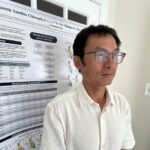ESSIC / AOSC researcher and University of Maryland professor Ross Salawitch is currently preparing for his role as a Co-PI of a project that will measure the composition of air in the tropical western Pacific (TWP) region of the world.
Known as CONTRAST or “CONvective TRansport of Active Species in the Tropics,” the mission will consist of a series of airborne observations conducted from Guam during January and February of 2014.
Salawitch is among three principal investigators for the project; Laura Pan of the Atmospheric Chemistry Division at NCAR and Elliot Atlas of the University of Miami are the two additional PIs for the mission.
CONTRAST is occurring in the TWP due to unique characteristics of this region. Biological processes in warm ocean surface waters produce halogen-bearing organic molecules that accumulate in the lower atmosphere; convection lofts these biogenic halocarbons into the upper troposphere; further transport results in the composition of the lower stratosphere and global troposphere potentially bearing a signature of ocean biology.
“The importance of conducting an aircraft-based field campaign in the TWP was established in 1999 at a NASA workshop held in Snowmass, Colo” said Salawitch. “Our 2014 field campaign represents the culmination of many years of planning.”
The TWP is vast. CONTRAST will partner with two other missions to sample this region. Each mission will provide an aircraft to measure the composition of air in various locations.
One partner, CAST, will utilize a British aircraft called the BAe-146. This aircraft will observe gases and particles at the bottom of the atmosphere, the so-called marine boundary layer. Flights will target characterization of the atmospheric impact of biology in shallow coastal waters.
CONTRAST will utilize the NCAR Gulfstream V (GV), which has a maximum altitude of 14.5 kilometers, to sample the region of convective outflow. These flights will quantify the impact that energetic storms have on the local atmosphere.
“The GV samples above the level of net zero radiative heating, so we will measure air that is later transported to either the global troposphere or the lowermost stratosphere,” said Salawitch.
The other partner, ATTREX, will utilize the NASA Global Hawk (GH), a remotely piloted airplane that can stay aloft for 24 hours. The GH will can reach 20 kilometer altitude, allowing sampling of the cold point tropopause.
“The tropopause in the TWP is colder during Jan and Feb than anywhere else in the world,” Salawitch said. “A lot of air that goes into the stratosphere passes through this region, is freeze dried and dehydrated. ATTREX is designed to quantify the processes that control the abundance of stratospheric water.”
“The tropics are vast, it’s a huge region, and that means we had to use multiple aircraft,” said Salawitch. “CAST and ATTREX are ideal partners.”
“We will attempt to stage these three airplanes in harmony, to measure the atmospheric composition of TWP when both ocean biology and atmospheric storms are raging,” Salawitch said.
According to Salawitch, utilizing all three of these aircraft is very important when it comes to drawing conclusions from the mission. By connecting the observations, Salawitch says they can then make generalizations. Conducting a single experiment would not derive conclusive results.
“Our goal is to do statistical Lagrangian trajectory experiments where we sample certain persistent patterns of the meteorology,” said Salawitch.
Salawitch says he feels comforted by having Pan and Atlas as his co-principal investigators because they complement each other so well. Although he admits he never thought it would take this long to conduct a field campaign in the TWP, Salawitch says it was never forgotten due to its extreme importance.
“It feels great that we’re going to fulfill a vision that was put forth almost 15 years ago,” Salawitch said.
The team has a number of testable hypotheses and well-formulated ideas that they plan to examine. However, according to Salawitch, he hopes to find some surprises.
“I believe a true understanding occurs when you break your model, when you show that preexisting ideas are just wrong,” Salawitch says. “And so you must recover and put together new ideas.”
For the moment however, Salawitch said his focus remains solely tied to preparation for the mission’s January 2014 commencement.





